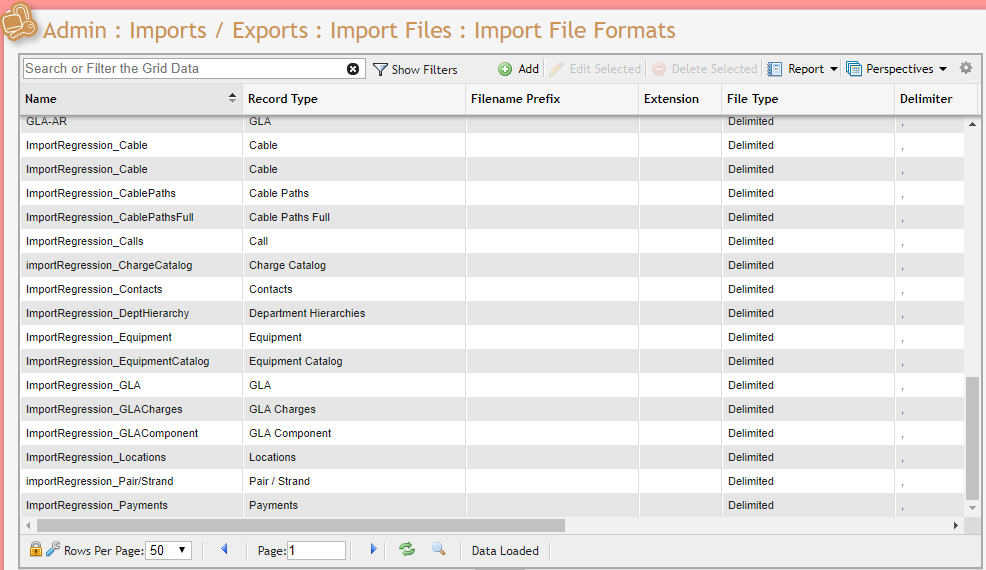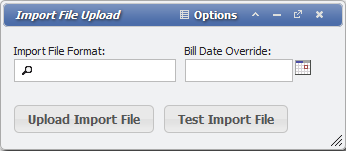Expense Management
Overview
Expense Management allows the User to manage Vendor Invoices and provides mechanisms for Invoice Reconciliation. This feature allows the User to verify Vendor Invoices and feeds. Expense Management provides a text and graphical history of Vendor Invoices. Users have the ability to see changes month to month invoices and also view reports on charges and discrepancies.
Note: Expense Management is designed to help the User manage their carrier bills and charges. These charges are separate from other charges within PCR-360 and do not appear on the bills.
Expense Management involves using the Import File process to import Vendor Invoices.
Audit Charges Graph
Creating Import File Formats

Navigate to the Import File Formats grid by opening the 'Admin' tab and clicking on the node labeled 'File Management'. Click on the node labeled 'Import Files'. Then click on the node labeled 'Import File Formats'. To add a new import file format, click the 'Add' button on the Grid Toolbar above the Import File Formats Grid.
Add New Import File Format form
In the data entry form, the User must define a number of required fields.
First, give the new import file format a Name. Next, define the File Type as either Delimited or Fixed width. If the User defines the File Type as Delimited, the User must also define a Delimiter (generally a comma but not necessarily). Next, specify the number of 'Header Lines' and 'Footer Lines' that exist on the file to be imported, if any.
A User can also specify the optional 'Retention' value. This is a number of days to keep the Import Files and Imported Records that are imported with this Import Format. This does not affect the data that was imported, it just cleans up the logs and original raw files of the import job. If this is blank, then the old logs are never deleted.
Users can also define the fields under the header 'Record Volume Notifications'. When a 'Low' and 'High' threshold is specified, the PCR-360 application will automatically send an email to the 'Recipient' if the file is above or below a certain size.
The 'Record Format Flag' values allow a User to specify a position or delimited index where there might be a value that will determine if the input line should be processed. This is described more below.
The Import Process has the ability to automatically process files that are put into a directory on the server. For this to work, the filenames must match the values provided in the Filename Prefix and Extension fields. The Filename will match if it begins with the same characters provided in the Prefix field. The Extension must exactly match. If no value is provided for the Extension, then the Filename extension must be blank. More information about uploading a file can be found here.
If the 'Allow Duplicate File' checkbox is set, then it will allow you to upload and process the same file content twice. This does not check the filename, it is checking the file content. For most import types this can be turned on. It is turned off by default as a precaution against accidentally uploading the same GLA Charge or Service Charge file twice, which will create duplicate charges. If this checkbox is turned off, then an error will happen on the upload of a duplicate file.
Import File Record Format
From the Import File Format form, click the 
Note: An Import File Record Format will need to be added for each unique Service Catalog on a Vendor Invoice.
Examples of Threshold use:
A Threshold Percent of 10% indicates that if the imported cost is 10% greater than, or 10% less than the expected value, an error will be triggered.
A Threshold Amount of 5.00 indicates that if the imported cost is $5.00 greater than, or $5.00 less than the expected value, an error will be triggered.
A Threshold Status Days of 90 indicates that if the Service Status is Inactive longer than 90 days from the imported file date, an "Unexpected Service Status" error will be triggered.
Expected Charge Codes:
To add additional Expected Charge Code, click the
Ignore flag is used to suppress warnings for the specified charge code and excluded from the Aggregate Report.
Optional flag is used to suppress the Expected Charge Not Found warning for the specified charge code while still checking the other Amount Thresholds.
Allow Dups flag is used to suppress warnings for duplicate charge codes.
New Import File Record Format
Uploading Files
After the format of the file to be imported has been defined, as described in the 'Import File Formats' article, the User can upload the file into the PCR-360 application.
Navigate to Admin>Imports/Exports>Import Files>Import Files. From the Grid, click the button:


From the Import File Upload form, the User must select an 'Import File Format' from a list of items on the Import File Formats grid.
Before uploading, it is recommended that the User tests the upload by clicking the button:
and selecting the appropriate file to be imported from the user's computer.
The User can also choose to upload the file by clicking on the button:

The User is then prompted to select the appropriate file to be imported from their computer. When a file is selected for upload, the upload process begins immediately. After the file is uploaded it will appear in the Imported Files grid in an unprocessed state. The import process will begin in the background within a couple of minutes.
Fields
Service Identifier
Required
Datatype is String
Charge Code
Required
Datatype is String
Invoice Amount
Datatype is Decimal
If blank, Amount validations will be skipped.
Reports
PCR-360 offers two ways to verify Vendor Invoices: The Audit Report and Aggregate Reports.
Audit Report
The Audit Report will allow Users to easily view each discrepancy found, along with the Audit Code, Services Identifier, Invoice Amount, and Expected Amount based on the Thresholds the User defines.
Expense Management Audit Report
Aggregate Reports
The Aggregate Report provides a text and graphical view of the total charges of the Vendor Invoices. This can be filtered to show only the information the User wants to see. The graph is a representation of the data displayed on the grid.
Expense Management Aggregate Report
